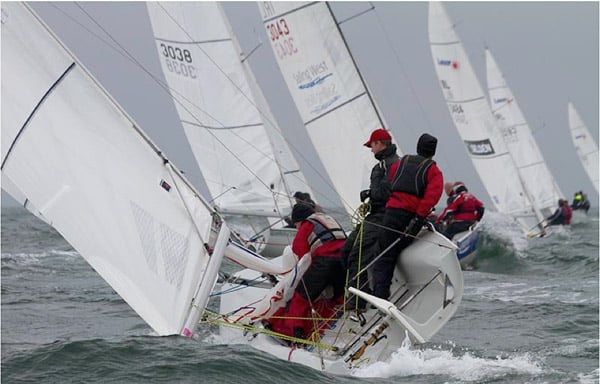Displaying items by tag: SB3 Nationals
Flannigan's Ulster Trio Take SB3 Title
The Royal Ulster YC crew of Gareth Flannigan/Brian Spence/Jeremy Tomlinson were the emphatic winners of the Investwise SB3 National Championship at Howth with a remarkable 17.5 points margin over runner-up 'Yeti' (Sean Craig/Stephen Boyle/Alan Green) of the Royal St.George YC, with early pacemaker 'Sharkbait' (Ben Duncan/Brian Moran/Ric Morris) of HYC a further two points adrift.
The northerners simply got better and better as the series unfolded. After a tentative start with an 8th and a 6th on day one, they strung together an impressive record of three bullets and three seconds, clearly revelling in the strong wind conditions over the weekend.
They arrived in Howth as the pre-event favourites on the back of top class performances at the four regional championships and did not disappoint. Overnight leaders going into the last day, they only had to steer clear of trouble and keep an eye on Craig and Duncan to be sure of overall victory.
Winning the penultimate race (just ahead of Craig and with Duncan back in 17th) effectively sealed the title but the last race threw up the highly unusual result in one-design racing of a tie for line honours with 'Bullet' (Trevor D'Arcy and crew from Carrickfergus), with Duncan salvaging a third after several average results.
Discarding an 8th was a clear indication of the Royal Ulster crew's dominance of the event and the pre-event predictions as to who would be the podium finishers was highly accurate. In addition to the top three, there were four other northern crews and four Dun Laoghaire boats in the top ten.
Duncan was the leading local boat in 3rd overall, although two other Howth crews 'Flying Saucers' (Emma McDonald) and 'Lia' (Dave Barry) filled 11th and 12th places respectively.
David Quinn of sponsors Investwise, who competed himself and finished mid-fleet, was delighted with the event which, with 49 entries, ranks as one of the biggest one-design class championships in the country. Organisation of the championship was headed up by Suzanne Carroll and her committee.
SB3 NATIONALS PHOTO GALLERY BY GARETH CRAIG HERE
SB3 NATIONALS PHOTO GALLERY BY BRIAN CARLIN HERE
Investwise SB3 National Championship – overall result:
1. McCreadys Gill Team (Flannigan/Spence/Tomlinson) RUYC 15.5 pts
2. Yeti (Craig/Boyle/Green) RStGYC 33 pts
3. Sharkbait (Duncan/Moran/Morris) 35 pts
4. Flutter (Algeo/Knatchbull/Haughton) RStGYC 47 pts
5. Bad (Hyde/Dowling/Dowling) RIYC 53 pts
6. Toucan 3 (Vaughan & crew) RNIYC 57 pts
Day Two: Flannigan Takes the SB3 Lead
Leaders from day one Ben Duncan, Brian Moran and Ric Morris had a more testing day with some interesting action at the start of race 4 and 5 leaving them playing catch up. Scoring 6,11,7 they slip back to second tied with Sean Craig (5,3,10). Winner of todays final race Andrew Algio, Garry Houghton and Richard Knatchbull added a 13th and a 6th to a win in the final race to move up to 4th. Ross Vaughan, Rory Fitzpatrick and Ryan Seartons 11, 1, 33 was enough to move them up to 5th.

Squally conditions on Day two of the SB3 Nationals. Photo: Gareth Craig. More photos HERE.
HOWTH YACHT CLUB. SB3 NATIONALS (O'ALL) 04/09/2010 SB3: 1, McCreadys Gill Team Gareth Flannigan RUYC (13.00); 2, Sharkbait Ben Duncan HYC (21.00); 3, Yeti Sean Craig RStGYC (21.00); 4, Flutter Andrew Algeo RStGYC (34.00); 5, Toucan 3 Ross Vaughan RNIYC (38.00)
Day Two photos by Gareth Craig HERE.
Going Right Pays Dividends for Boomsticks (SB3 vid HERE)
Sharkbait Takes Early Lead at SB3 Nationals
Ben Duncan, Brian Moran and Ric Morris on Sharkbait have eased into an early lead after day 1 of the Investwise SB3 Ireland National Championships in Howth. Sailing on their home waters the Howth Yacht Club team took home 2 bullets and a 6th to lead over night by 4 points from Stefan Hyde, Jerry Dowling and Jimmy Dowling. Brian Reilly, Sam Hunt and Conor Clancey lie 3rd, with Sean Craig, Stepen Boyle and Alan Green in fourth and McCready Gill Racing Team in 5th.
Photos by Gareth Craig on the gallery HERE
Stars on show at Investwise SB3 Nationals at Howth
Among the highly competitive fleet will be four or five past or present Olympians, former national champions in several classes and a couple of All-Ireland Champions, a formidable line-up by any standards. Such is the quality of the field that any one of 10 crews is capable of taking the title, with consistency the key over the 8 races on the schedule.
The 'bookies favourite' is undoubtedly 'McCready's Gill Racing' sailed by Gareth Flannigan/Brian Spence/Jeremy Tomlinson from Ballyholme who already have two wins and two runners-up places in the four regional championships sailed this season. Former Olympian Peter Kennedy from RNIYC is the defending champion and with a new crew on 'Belfast Kitchens' has been building slowly throughout the year - their performance at the recent Westerns suggests they are very much in contention.
While the Northern fleet has been dominant in SB3s since the class was formed, they cannot discount the top performers from Dun Laoghaire, Howth and the South. Leading the southside challenge will be 'Yeti' (Sean Craig/Stephen Boyle/Alan Green), a prediction for a top 5 finish, while 'Bad' (Stefan Hyde/Jerry Dowling/Jimmy Dowling) has been improving ever since the Northern Championships
.
The host club's best bet is 'Sharkbait' sailed by Ben Duncan/Brian Moran/Ric Morris, a combination that is consistently at the top of the fleet (e.g. winning the Northerns) and tops the ranking ladder with Flannigan. A 'podium finish' is anticipated. The event sponsor David Quinn and his crew on 'Investwise' have enjoyed good form of late while 'Lia' (helmed by Dave Barry) has improved since a trip to Lake Garda.
The southern challenge is headed by 'Modus Operandi' (sailed by Ronan and Killian Collins and Donal Hegarty) which has the potential to upset the odds if they can put a steady campaign together.
Race Officer is David Lovegrove while Suzanne Carroll has masterminded the organisation of the event as chair of the Championship Committee.

































































